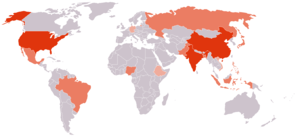Leí este artículo... les presento solo el principio con los datos q seguro los dejarán "picados"... visto en Optimum Population Trust
Defining an optimum population
An ‘optimum’ population, in dictionary terms, is the ‘best or most favourable’ population. But a dictionary cannot tell the whole story. Best for what purpose, and best according to which criteria? For OPT, a green think tank, an optimum population means, at its simplest, a population size which is environmentally sustainable in the long term, affords people a good quality of life, has adequate renewable and non-renewable resources necessary for its long-term survival and consumes or recycles them to ensure it will not compromise the long-term survival of its progeny.
Few would argue with the statement that ‘population cannot continue to increase indefinitely’. But how do we define the limit? Using a tool called Ecological Footprinting*, which provides a snapshot of human ecological impact under given circumstances, it is possible to throw some light on this question.
(* Ecological footprinting data given in this paper have been taken from Global Footprinting Network research published in the WWF Living Planet Report 2006, using 2003 data.)
A sustainable population for Earth
- Assuming the global biocapacity and average footprint [F1] remain stable at the 2003 level, then, to become sustainable, the world population needs to contract to a maximum of 5.1 billion.
- For a ‘modest’ world footprint of 3.3 gha/cap (without allowances for biodiversity or change of biocapacity), the sustainable population is 3.4 billion.
- For a ‘modest’ world footprint of 3.3 gha/cap, plus a 12% allowance for biodiversity (but none for attrition of biocapacity), the sustainable population is 3.0 billion.
- For a ‘modest’ world footprint of 3.3 gha/cap, plus a 20% margin for biodiversity and attrition of biocapacity then the sustainable population is 2.7 billion.
The 15 most populous nations
Approximately 4300 million people live in these 15 countries, representing roughly two-thirds of the world's population. If added together, all nations in the European Union, with 494 million people – about 7.3% of world's population in 2006 – would be third in the list below.
| Country[13] | Population (millions) | Percentage (of world) |
|---|---|---|
| China | 1,321 | 19.84% |
| India | 1,132 | 16.96% |
| United States | 304 | 4.56% |
| Indonesia | 232 | 3.47% |
| Brazil | 187 | 2.80% |
| Pakistan | 163 | 2.44% |
| Bangladesh | 159 | 2.38% |
| Nigeria | 148 | 2.22% |
| Russia | 142 | 2.13% |
| Japan | 128 | 1.92% |
| Mexico | 107 | 1.60% |
| Philippines | 89 | 1.33% |
| Vietnam | 84 | 1.31% |
| Germany | 82 | 1.23% |
| Egypt | 81 | 1.13% |
| Total | 4,356 | 65.32% |


No hay comentarios:
Publicar un comentario